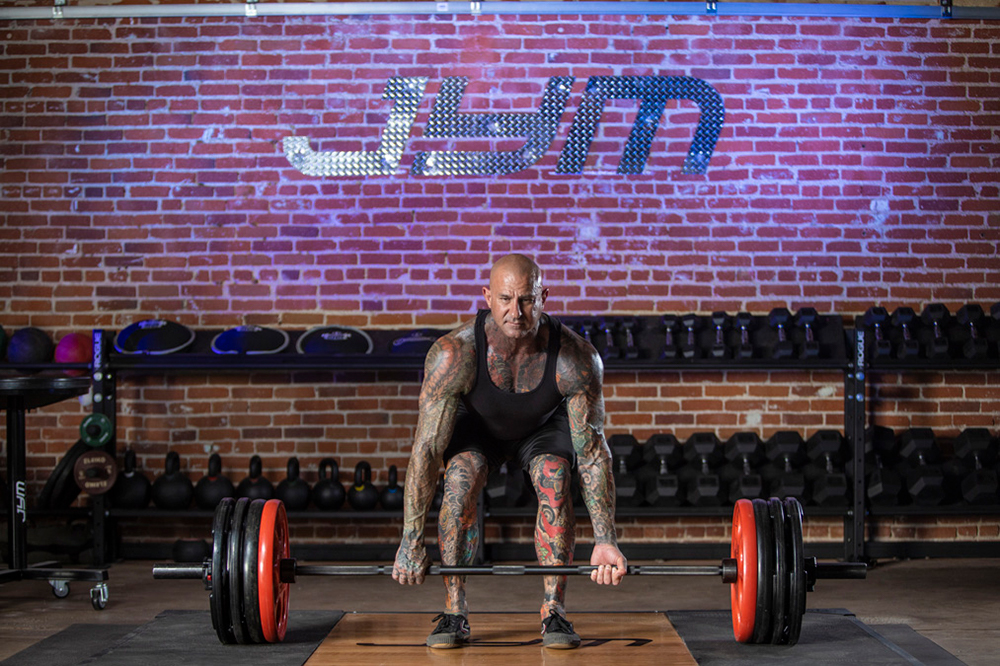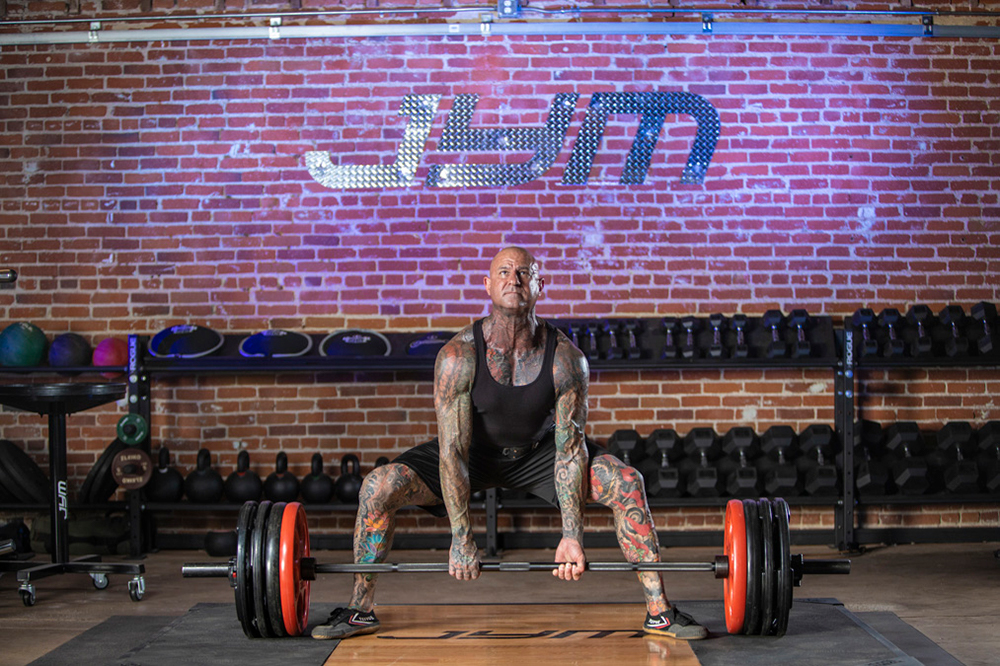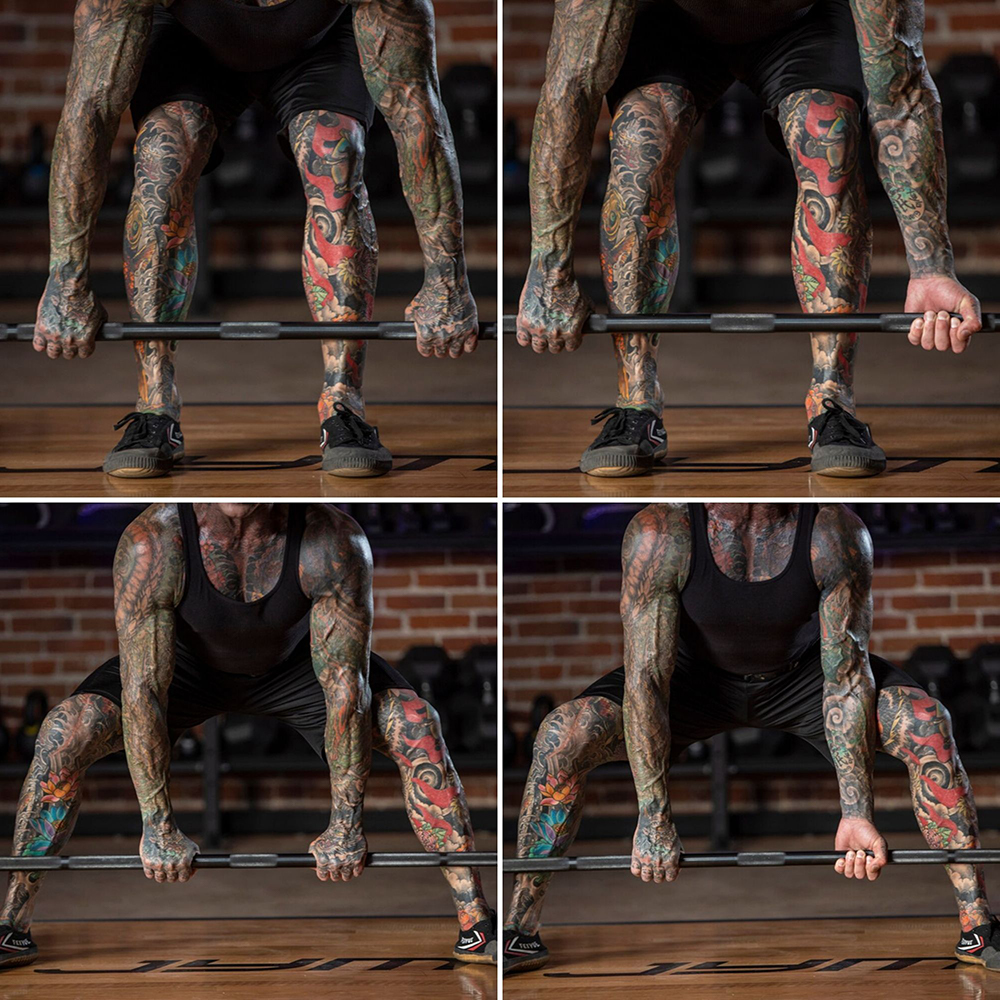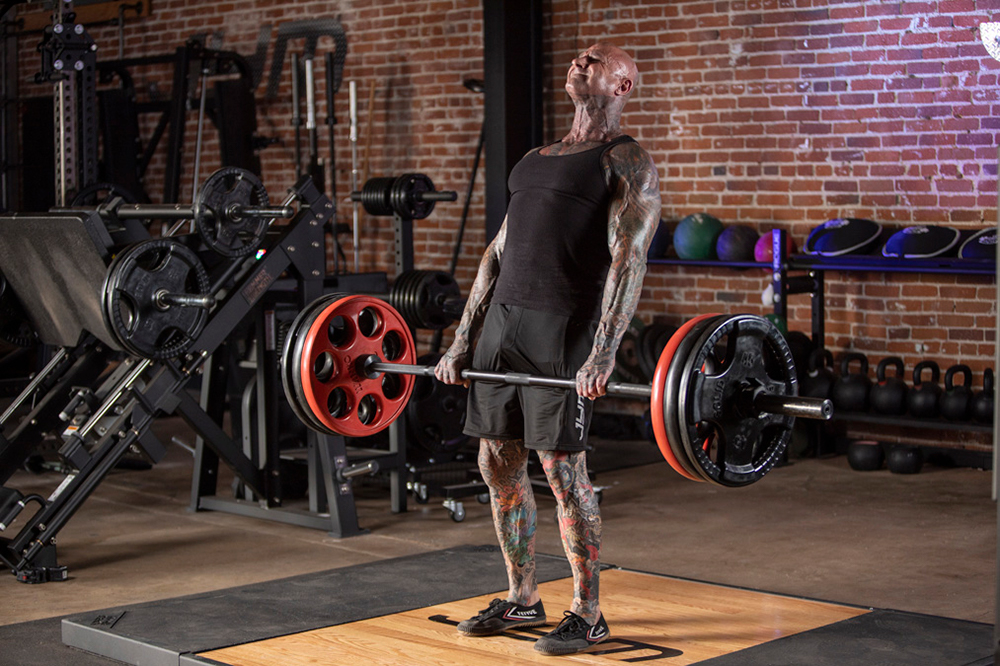Deadlift Tips
The deadlift is an exercise that truly tests and displays your overall strength. Use the tips below to find out how to boost your deadlift numbers, as well as advice on how to fit this powerhouse technique into your workouts.

The deadlift is an exercise that truly tests and displays your overall strength. Use the tips below to find out how to boost your deadlift numbers, as well as advice on how to fit this powerhouse technique into your workouts.

The deadlift is considered the ultimate test of overall body strength. That's because it utilizes muscles in both the lower body and the upper body. These muscles primarily include the hamstrings, glutes, quads, and even the calves, as well as some of the back muscles such as the traps and the lats, and of course the spinal erectors. Yet when you consider that the arms remain straight and simply hold the bar throughout the entire deadlift, you realize that the legs are the prime movers, meaning that the deadlift is mainly a lower body exercise.
So why do so many bodybuilders do deadlifts on back day?
One reason deadlifts are thought of as a back exercise is due to the fact that the squat is considered the king of leg exercises, and if you do both squats and deadlifts on the same day one of them will suffer as far as strength goes. This is not the case for powerlifters who typically have a dedicated squat day, a dedicated deadlift day, and a dedicated bench press day. But since bodybuilders and most of us who are not competitive powerlifters split up our training by muscle groups, we're left with the dilemma of when to do deadlifts. Since there is some back involvement on deadlifts, many do them on back day.
But I highly suggest that for those of you who do not have a dedicated deadlift day to do deadlifts on leg day, despite the fact that you also squat on leg day.
How do you do that without your squat or deadlift strength from suffering? By alternating the order that you do them. In one workout, do squats first and deadlifts later in the workout; in the next workout, do deadlifts first and squats later. This way you train them each when you are at your strongest, and your strength will not suffer, nor will your leg development. In fact, for those of you who have difficulty building up your leg size and strength, adding deads to your leg day will help you to really bring up your leg size and strength.
For a workout program that uses both squats and deadlifts, clink on the link below for my Dead Legs Training Program:
If you've ever watched a powerlifting competition, you may also wonder why some guys use a conventional deadlift style and others use the sumo-style deadlift. That really depends on your biomechanics and which style of deadlifting you are strongest on.
However, one advantage of the sumo-style dead is that, due to the wider stance, you do not have to lift the bar as high. Achieving the shortest range of motion possible is key when trying to maximize how much weight you can lift in competition. The sumo-style dead may also be best suited for those with stronger quads—but more on that in a bit.
Regardless of whether you are a competitive powerlifter or not, you should be using the deadlift in your workouts, and you actually should be using both styles of the deadlift in your workouts for best leg development and strength. So let's cover how to do both and what the difference is in the biomechanics and the muscles used.

Load a barbell on the floor. Stand over the bar with a stance that has your feet spread about hip-width apart. Step up to the bar so that it's midfoot. That way when you squat down to grab the bar the shins move forward and touch the bar. Grab the bar with a shoulder-width grip. Then squat down so that your legs are just above parallel with the floor and your torso is bent forward at about a 45-degree angle with the floor.
Start the dead by pushing through your heels to lift the bar by first extending at the knees. As the bar rises you will immediately start to extend at the hips, driving your hips forward, until you are standing in a fully upright position. Pull your shoulders back and lift your chest as you lean back in the top position. Hold this for a second and then reverse the order of the moves to lower the bar to the floor. Then repeat for reps. Be sure that while you are lifting and lowering the barbell that you keep the bar in constant contact with your legs.

Stand over a loaded barbell on the floor with your feet spread about twice as far as the conventional deadlift. Your feet should be turned out slightly. How far you spread your feet depends on leg length and comfort, so try a few different positions until you find the most comfortable one. Grab the bar with a shoulder-width grip and squat down so that your thighs are just above parallel with the floor. Bend forward from the hips so that your torso is bent forward. The sumo style dead allows you to keep your back a bit more upright than the standard dead.
Start pulling the weight by pushing through your heels to extend your knees and then immediately extend at the hips until you are completely upright with your shoulders pulled back and your chest up. Hold this position for a second and then lower the bar back to the floor and repeat for reps. As with the conventional dead, be sure to keep the bar in constant contact with your legs when lifting and lowering it.
The obvious difference between the conventional deadlift and the sumo-style deadlift is that the feet are much wider apart in the sumo style. But the sumo deadlift also differs in the muscle fibers that are used.
Researchers from Duke University Medical Center used EMG to compared the muscle fibers used when collegiate football players who were trained in both lifts, did the sumo-style deadlift or the conventional deadlift. They found that during the sumo-style dead they used more quadriceps, inner hamstrings (semimembranosus, and semitendinosus), and upper traps as compared to the conventional dead. And when they did the conventional deadlift they used more glutes and outer hamstrings (biceps femoris).
So be sure to do deads with legs, and use both styles of the deadlift to fully hit the hams and glutes, as well as the quads.

Regardless of the type of deadlift you are doing, I highly suggest that you hold the bar using a staggered grip. This is also known as an alternate grip and involves using an overhand grip with one hand and an underhand grip with the other. This will prevent the bar from rolling out of your hands and will significantly increase your grip strength on the bar.
A study I did with the Weider Research Group actually compared the use of a staggered grip to an overhand grip in trained weightlifters. We reported at the 2007 Annual Meeting of the National Strength and Conditioning Association (NSCA) that when they used the staggered grip they were able to complete more reps with a given weight than when they used the overhand grip.
I also suggest that you consider using weightlifting chalk to keep your grip from slipping.
Barbells are covered with oil from people's skin, including your own. Using chalk can prevent your grip from slipping and keep both your grip and your deadlift strong. And if your grip is a bit weak and holding back how much you can deadlift then I suggest you use wrist straps. Don't use the deadlift as a way to strengthen your grip while compromising your strength and muscle growth in your lower body. Use wrist straps if need be and save the grip strengthening for when you train forearms.
For a good grip-strengthening workout, click on the link below for my Get A Grip Workout:
Unlike in the squat, where having a shoe with a raised heel (such as work booths or Olympic weightlifting shoes) may be beneficial, with the deadlift you want as flat a shoe as possible. You also want a shoe with a minimal sole. The higher the shoe the greater the range of motion and the harder the deadlift becomes. I recommend Converse Chuck Taylor's, wrestling shoes, martial arts shoes (such as Feiyue), or Vibram FiveFingers. Or you may just want to go barefoot. Just be careful when sumo-style deadlifting barefoot or in socks, as the spread stances may cause your feet to slide out more as you lift the bar, so you may need some traction to prevent slipping.

The deadlift is, as I said, considered the ultimate test of overall strength. Because of this, it's a great exercise to include in your training for increasing full body strength. If you've done your fair share of deads then you know that the sticking point of the deadlift is when the bar reaches knee height. So powerlifters have been using for decades a technique called lockouts. This involves partial rep training where you place the bar in a power rack at knee height and performing deadlifts from this position up to lockout position (the top position of the deadlift).
Yet according to research from Kennesaw State University (Georgia), this method of lockouts may not be the best way to increase your strength through the sticking point and boost up your strength on deads.
They analyzed the lifting biomechanics during the deadlift of 25 male competitive powerlifters during a regional powerlifting competition using videography. They did confirm that the sticking point of the deadlift is when the bar reaches knee height—but they also discovered that the speed of the bar significantly slows down when the bar is about 2.5 inches below knee height. This means that the common practice of doing lockouts with the bar set at knee height in a power rack is likely not the best way to train to get stronger through the sticking point of the deadlift.
That's because you need to train in the position where the bar starts to slow down, which is a few inches below knee height. A better method would be to do lockouts with the bar about 3 inches below knee height to train the entire area where the bar starts to slow down and "sticks".
To increase your strength through the sticking point of the deadlift and therefore your strength on deads, as well as your overall strength, consider doing lockouts—just start them lower. To do this, set the bar in a power rack at a height that is about 3 inches below knee height. Perform deadlifts with the bar in this position to full lockout position. Do about three sets of 3-6 reps at the start of your deadlift workout while you are strongest. Be sure to try to perform the reps as fast and explosively as possible, even when the weight is heavy and moving slow. Attempting to move heavy weight quickly, even if you can't actually move it quickly, will increase speed and power. Then finish with three to four sets of full range of motion deadlifts.
Below is a video I did on implementing cardioacceleration in your leg workouts. A lot of people forego cardioacceleration on leg day since big compound exercises like squats, deadlifts and lunges take a lot out of you and burn a ton of calories in their own right. I get it—I used to never do cardioacceleration on leg day, either.
But if you're avoiding cardioacceleration on leg day because you think it's going to zap all your strength, I strongly suggest rethinking this approach—you can (and should!) do cardioacceleration during lower body workouts, particularly if you want to maximize fat-burning and stay lean. As I mention in the video, you can still do your squats and deads with appreciable weight while doing cardioacceleration because it's a form of active recovery.
The key is selecting the right cardioacceleration exercises. The large muscles of the lower body (glutes, quads, hamstrings) do need some rest between heavy sets of big lifts, so you probably don't want your cardioacceleration moves between sets of deadlifts and barbell squats to be jumps squats and step-ups.
Instead, I recommend focusing on core/ab exercises that also involve the lower body, albeit to a much lesser degree than true leg exercises. My personal favorites here include band woodchoppers, band roundhouse elbows (an MMA-inspired move), battle ropes, barbell rollouts, medicine ball slams, heavy bag work and hanging leg raises.
I covered the general parameters of leg day cardioacceleration in the Tip of the Day video, but I also wanted to give JimStoppani.com members an exclusive sample workout that incorporates these principles. This particular routine is centered around deadlifts, but you can also do the same thing for squats; if you choose to, simply sub in barbell squats for deadlifts in the workout and do deadlifts on a different day. (Note: "C.A." in the workout chart is short for cardioacceleration.)
| Exercise | Sets | Reps | C.A. |
|---|---|---|---|
| Deadlift | 4 | 6-8 | Band Woodchopper* |
| Barbell Lunge | 4 | 12-15 | Barbell Roll Out |
| Barbell Hack Squat | 4 | 20 | Medicine Ball Slam |
| Leg Extension | 4 | 15 | - |
| Superset with | |||
| Lying Leg Curl | 4 | 15 | Jumping Jacks |
| Romanian Deadlift | 4 | 10 | Hanging Leg Raise |
*Rest 1-2 minutes between sets of deadlifts, with 1 minute of that time doing cardioacceleration (band woodchoppers).
Rest 1 minute between sets of all other exercises, doing cardioacceleration for as much of that time as possible.
As I discussed above, core exercises like woodchoppers and barbell rollouts are great to do between big lower body lifts because they involve more or less the whole body without over-taxing the legs. That said, I also included jumping jacks in this workout simply for practical reasons—because doing woodchoppers or rollouts may not be feasible in the immediate vicinity of the leg extension and leg curl machines at your gym. Jumping jacks, of course, can be done anywhere because they don't require any equipment.
Hanging leg raises do require equipment, so that's why I paired them with Romanian deadlifts. Romanians require a barbell, but you can easily carry a fixed weight bar over to the hanging leg raise bench and do these exercises side by side. I paired barbell rollouts with lunges because you can use the same bar for both exercises.
Whatever the situation, feel free to replace any of the cardioacceleration exercises listed in the workout with others that are more practical. For example, if you don't have any elastic bands at your gym but you do have a medicine ball (one that won't bounce up and smack you in the face), sub medicine ball slams in place of band woodchoppers. Or, if you have the space to jump rope near the leg extension and leg curl machines, do that instead of jumping jacks if you want. All gyms are different, so I can't always predict what will be practical from an equipment standpoint at your gym.
Related Articles